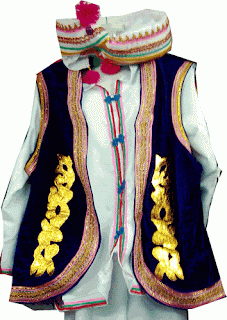As a large united multi-national state, China is composed of 56 ethnic groups. Among them Han Chinese account for 91.59% of the overall Chinese population and the other 55 make up the remaining 8.41% . As the combined population of these other ethnic groups is far fewer than that of the Han, they form the 55 ethnic minorities of China. These numerous ethnic groups share China's vast lands but at the same time many live in their individual communities. The relationships between the different ethnic groups have been formed over many years. The 55 ethnic minorities have their own festivals, traditional clothing, life styles, cultures, customs, languages, or even written languages, and their life is always full of color and pleasure.
Major Chinese ethnic minorities map
Because of the huge number, it is impossible to involve all the 56 ethnic groups in this post, so I will just talk about three major ethnic minorities.
Bai Ethnic Minority
The Bai costume has a long history. As long as 1,800 years ago, the Bai wove a kind of cloth known as "Tonghua.” During the Nanzhao Regime and the Dali Kingdom, the Bai created their own styles of clothing. Now, the clothes of the Bai people are bright and well-matching in colors, delicate and fine in embroideries, and plain and simple in style.
Bai clothing is usually adorned with camellia flowers because they view these flowers as a symbol of beauty. The Bai enjoy their lives and love flowers. They like to wear a red scarf on their shoulders and a white outer upper garment, a combination that resembles blooming camellias.
Bai Ethnic Minority
The Bai costume has a long history. As long as 1,800 years ago, the Bai wove a kind of cloth known as "Tonghua.” During the Nanzhao Regime and the Dali Kingdom, the Bai created their own styles of clothing. Now, the clothes of the Bai people are bright and well-matching in colors, delicate and fine in embroideries, and plain and simple in style.
Bai clothing is usually adorned with camellia flowers because they view these flowers as a symbol of beauty. The Bai enjoy their lives and love flowers. They like to wear a red scarf on their shoulders and a white outer upper garment, a combination that resembles blooming camellias.
The Bai clothing for females
The Bai clothing for males
Mongolian Ethnic Minority
Many Mongols live in modern urban housing for a part of the year, but switch to the ger. At other times of the year in order to tend to domestic animals (sheep, goats, etc.). The Mongolian ger is practical in every way: it is quickly collapsible and packs away to almost nothing, making it easy to transport; its ground-hugging base and its conical top - which also sheds rain instantly - help keep the ger snug to the ground, even in strong winds; and inside, it is very roomy and ventilated. The Mongolian ger consists of a wooden, lattice frame, sometimes in sections.
Gers
Inside of a ger
Tibetan Ethnic Minority
Tibetan people believe in Lamaism. The believers must recite or chant Buddhism scriptures very often. For illiterate people, what they can do is to turn prayer wheels, with scriptures inside. Turning the prayer wheel is equivalent to chanting some scriptures and it has become routine work for Tibetan people. A lot of Tibetans keep portable prayer wheels at home. Prayer wheels are of different sizes and quality. But there is one thing in common, that is they all have scriptures inside. Followers of Yellow sect turn the wheel clockwise, while followers of Black sect turn it anticlockwise.
Lamas in a lama temple






No comments:
Post a Comment